Measurement and Comparison of the Innovation Spatial Spillover Effect: A Study Based on the Yangtze River Delta and the Pearl River Delta, China
Abstract
:1. Introduction
2. Literature Review
3. Study Area, Model and Data
3.1. Study Area
3.2. Econometric Model Construction
3.3. Data Description
- Talent plays a key role in innovative knowledge creation, transformation, production, etc. We use the number of employees in scientific research, technical services and geological prospecting reflecting the state of talent input (H), and its unit is the person.
- Funding investment reflects the government’s emphasis on innovation, which is characterized by science and education expenditures (K), which is CNY 10,000.
- Urban development level not only affects the innovation demand, but also affects the urban innovation investment scale [28]. Urban development level (Dep) is characterized by the disposable income of urban residents in CNY.
- Under the background of globalization, urban innovation is affected by foreign investment and foreign trade, and the openness level is characterized by the total amount of urban import and export trade (Open). The unit is 100 million yuan.
- Innovation is a capital-intensive production activity. The financial level affects innovation by improving financing constraints and improving technology absorptive capacity, characterized by the balance of loans from financial institutions at the end of the year (Fin), and its unit is CNY 100 million.
3.4. Econometric Model Selection
- It is necessary to confirm the existence of spatial correlation first. Based on relevant research methods [5,6], regression analysis is performed using the ordinary least squares model (OLS), and the spatial correlation of OLS regression residuals is identified. The results are provided in Table 1 and Figure 5. Table 1 indicates that increases in innovation investments, such as talent and funding, as well as improvements in the urban development environment significantly promote innovation. However, there are differences in the driving effect of different regions; for example, funding is significant in the Yangtze River Delta and nonsignificant in the Pearl River Delta, and development level is nonsignificant in the Yangtze River Delta and significant in the Pearl River Delta. Figure 5 indicate that the OLS regression residuals show a significant spatial correlation in both regions, indicating that the OLS regression estimation results ignore the innovation spatial correlation and cannot accurately reflect the objective reality, i.e., a spatial econometric model is necessary.
- 2.
- For this paper, the most important thing is to choose the appropriate measurement model. Referring to existing studies [6,36], the econometric model is selected based on the tests in Table 2. Firstly, tests based on the LM and robust LM showed that the SEM and SLM correlation statistics are significant at the 0.1 significance level, indicating that the SLM is superior to the SEM, i.e., there is significant spatial dependence. Secondly, based on the Wald and LR tests, it is judged whether SDM can be simplified to SEM and SLM. The results show that the relevant statistics all pass the 0.1 significance level; that is, the SDM cannot be simplified to the SLM and SEM. Finally, the Hausman statistic and probabilities all passed the significance test at the 0.01 level, i.e., the fixed-effects model was chosen [14,36]. Therefore, the spatial Dubin model is the best model for this empirical study.
4. Results
4.1. Measurement of the Spatial Spillover Effect
4.2. Robustness Test
4.3. Regional Heterogeneity of the Spatial Spillover Effect
4.4. Temporal Heterogeneity of the Spatial Spillover Effect
4.5. Geographical Distance Threshold Evolution Pattern of the Spatial Spillover Effect
- Further comparison shows that the strongest spillover effect in the Yangtze River Delta is at 400 km, and that in the Pearl River Delta is 200 km. The highest spillover effect for the Yangtze River Delta is significantly larger, which is the result of comprehensive effects of urban competition–cooperation and radiation outward from central cities, especially related to the factor concentration brought by the distribution of central cities and their development conditions [37].
- When the distance thresholds of the Yangtze River Delta and the Pearl River Delta exceed 400 km and 200 km, respectively, the spatial spillover effect does not decrease significantly; that is related to the region spatial structure. For example, in the layout of central cities, those of the Yangtze River Delta are relatively evenly distributed and the Pearl River Delta is adjacent to Guangzhou and Shenzhen, while the overall spatial structure of the region is relatively regular in the Yangtze River Delta and approximate triangular in the Pearl River Delta. That is, the polycentric spatial structure brings about fluctuations in spatial spillover effect. According to existing study [39], the innovation pattern in Anhui Province exhibits a significant monocentric spatial structure, and the spatial spillover effect is at its largest at 125 km and then significantly decreases with increasing distance threshold. A comprehensive comparison verified the relatively strong spatial spillover effect of polycentric structures.
- In addition, the significant decrease in the spatial spillover effect for the Pearl River Delta in 325–350 km, may be related to the fact that most cities are within 350 km of Guangzhou and Shenzhen. That is, the irregular pattern beyond this distance threshold does not result in a concomitant increase in integrated city numbers, and it also validates the correlation between the urban spatial distribution pattern and the spatial spillover effect. The results also indicate that the elements and policies show stronger spatial agglomeration, which is also an important reason for the stronger siphon effect of high-end innovation elements in core cities [5].
- The first interval is 50–100 km. There are relatively few cities, the gap in innovation levels is small, the competition for elements such as policy and talent are more intense, and the innovation spatial spillover effect is significantly weaker.
- For the second interval, the distance threshold for the Yangtze River Delta is 100–400 km, and for the Pearl River Delta is 100–200 km. Through competition–cooperation and cost–benefit within a certain range, cities can effectively share innovative resources, infrastructure and build a good division. The spatial spillover effect is significantly positive and gradually increases with increasing geographical distance threshold. Among the distances, 400 km is the distance that Shanghai to Hefei, and 200 km is the distance from Shenzhen to Zhaoqing, indicating that there is an optimal spatial boundary of the urban agglomeration integration region.
- The third interval is 400–800 km for the Yangtze River Delta and 200–800 km for the Pearl River Delta, respectively. As the distance increases, the opportunities for urban element exchange decrease, and the cost of innovation cooperation increases rapidly, generating an adverse impact on the division and cooperation. The spatial spillover effect is significant but continuously weakened, indicating that integrated cooperation still has an important practical significance in innovation for underdeveloped cities.
5. Discussion
5.1. Relying on the Urban Agglomeration Integration to Promote Innovation
5.2. Coordinating the Relationship between the Deepening and Spatial Expansion of Urban Agglomeration Integration
5.3. Establishing a Reasonable System to Guide Higher-Quality Innovation
5.4. Limitations
6. Conclusions
Funding
Data Availability Statement
Conflicts of Interest
References
- Capello, R.; Lenzi, C. Knowledge, innovation and productivity gains across European regions. Reg. Stud. 2015, 49, 1788–1804. [Google Scholar] [CrossRef]
- Li, Y.; Phelps, N. Knowledge polycentricity and the evolving Yangtze River Delta megalopolis. Reg. Stud. 2017, 51, 1–13. [Google Scholar] [CrossRef]
- Zhai, C.; Du, D.; Shi, W. Spatiotemporal evolution and determinants of the geography of Chinese patents abroad: A case study of strategic emerging industries. Systems 2023, 11, 33. [Google Scholar] [CrossRef]
- Jucevicius, R.; Jukneviciene, V.; Mikolaityte, J.; Saparniene, D. Assessing the regional innovation system’s absorptive capacity: The approach of a smart region in a small country. Systems 2017, 5, 27. [Google Scholar] [CrossRef]
- Shang, Q.; Poon, J.; Yue, Q. The role of regional knowledge spillovers on China’s innovation. China Econ. Rev. 2012, 23, 1164–1175. [Google Scholar] [CrossRef]
- Peng, W.; Yin, Y.; Kuang, C.; Wen, Z.; Kuang, J. Spatial spillover effect of green innovation on economic development quality in China: Evidence from a panel data of 270 prefecture-level and above cities. Sustain. Cities Soc. 2021, 69, 102863. [Google Scholar] [CrossRef]
- Méndez, R.; Moral, S. Spanish cities in the knowledge economy: Theoretical debates and empirical evidence. Eur. Urban Reg. Stud. 2011, 18, 136–155. [Google Scholar] [CrossRef]
- Fang, Z.; Razzaq, A.; Mohsin, M.; Irfan, M. Spatial spillovers and threshold effects of internet development and entrepreneurship on green innovation efficiency in China. Technol. Soc. 2022, 68, 101844. [Google Scholar] [CrossRef]
- Fujita, M. Towards the new economic geography in the brain power society. Reg. Sci. Urban Econ. 2007, 37, 482–490. [Google Scholar] [CrossRef]
- Audretsch, D.; Feldman, M. R & D spillovers and the geography of innovation and production. Am. Econ. Rev. 1996, 86, 630–640. [Google Scholar]
- Cui, W.; Li, L.; Chen, G. Market-value oriented or technology-value oriented? Location impacts of industry-university-research (IUR) cooperation bases on innovation performance. Technol. Soc. 2022, 70, 102025. [Google Scholar] [CrossRef]
- Krugman, P. Increasing returns and economic geography. J. Polit. Econ. 1991, 99, 483–499. [Google Scholar] [CrossRef]
- Autant-Bernard, C. Spatial econometrics of innovation: Recent contributions and research perspectives. Spat. Econ. Anal. 2012, 7, 403–419. [Google Scholar] [CrossRef]
- Sheng, Y.; Zhao, J.; Zhang, X.; Song, J.; Miao, Y. Innovation efficiency and spatial spillover in urban agglomerations: A case of the Beijing-Tianjin-Hebei, the Yangtze River Delta, and the Pearl River Delta. Growth Chang. 2019, 50, 1280–1310. [Google Scholar] [CrossRef]
- Rosenthal, S.; Strange, W. Geography, industrial organization, and agglomeration. Rev. Econ. Stat. 2003, 85, 377–393. [Google Scholar] [CrossRef]
- Glaeser, E. Learning in cities. J. Urban Econ. 1999, 46, 254–277. [Google Scholar] [CrossRef]
- Li, W.; Zheng, M. Is it substantive innovation or strategic innovation?: Impact of macroeconomic policies on microenterprises’ innovation. Econ. Res. J. 2016, 51, 60–73. [Google Scholar]
- Zhang, J.; Zheng, W. Has catch-up strategy of innovation inhibited the quality of China’s patents? Econ. Res. J. 2018, 53, 28–41. [Google Scholar]
- Gambardella, A.; Harhoff, D.; Verspagen, B. The economic value of patent portfolios. J. Econ. Manag. Strategy 2017, 26, 735–756. [Google Scholar] [CrossRef]
- Li, D.; Wei, Y.; Wang, T. Spatial and temporal evolution of urban innovation network in China. Habitat Int. 2015, 49, 484–496. [Google Scholar] [CrossRef]
- Romer, P. Increasing returns and long-run growth. J. Polit. Econ. 1986, 94, 1002–1037. [Google Scholar] [CrossRef]
- Griliches, Z. Patent statistics as economic indicators: A survey. J. Econ. Lit. 1990, 28, 1661–1707. [Google Scholar]
- Corinne, A.; James, P. Quantifying knowledge spillovers using spatial econometric models. J. Reg. Sci. 2011, 51, 471–496. [Google Scholar]
- Tobler, W. A computer movie simulating urban growth in the Detroit region. Econ. Geogr. 1970, 46, 234–240. [Google Scholar] [CrossRef]
- Timothy, G.; Ethan, L. Economic distance and cross-country spillovers. J. Econ. Growth 2002, 7, 157–187. [Google Scholar]
- Jaffe, A. Technological opportunity and spillovers of R&D: Evidence from firm’s patents, profits and market value. Am. Econ. Rev. 1986, 76, 984–1001. [Google Scholar]
- Fallick, B.; Fleischman, C.; Rebitzer, J. Job-hopping in Silicon Valley: Some evidence concerning the microfoundations of a high-technology cluster. Rev. Econ. Stat. 2006, 88, 472–481. [Google Scholar] [CrossRef] [Green Version]
- Cheng, K.; Zhang, Y. Measurement and decomposition of cities’ innovation spatial spillovers in China. Sci. Res. Manag. 2018, 39, 86–94. [Google Scholar]
- Wang, Q.; Hu, Z. A microlevel analysis on R&D firm agglomeration and magnitude of knowledge spillovers in continuous space. Sci. Geogr. Sinica 2018, 38, 1828–1836. [Google Scholar]
- Zhou, C.; Zeng, G.; Mi, Z.F.; Guo, X. The study of regional innovation network patterns: Evidence from the Yangtze River Delta urban agglomeration. Prog. Geogr. 2017, 36, 795–805. [Google Scholar]
- Acs, Z.; Anselin, L.; Varga, A. Patents and innovation counts as measurers of regional production of new knowledge. Res. Policy 2002, 31, 1069–1085. [Google Scholar] [CrossRef]
- Carlino, G.; Chatterjee, S.; Hunt, R. Urban density and the rate of invention. J. Urban. Econ. 2007, 61, 389–419. [Google Scholar] [CrossRef]
- Guan, J.; Yam, R. Effects of government financial incentives on firms’ innovation performance in China: Evidence from Beijing in the 1990s. Res. Policy 2015, 44, 273–282. [Google Scholar] [CrossRef]
- Ma, J.; Zeng, G.; Hu, S.; Sun, K. Innovation network structure of biomedical industry and its influencing factors in Yangtze River Delta. Res. Environ. Yangtze Basin 2022, 31, 960–971. [Google Scholar]
- Yan, D.; Sun, W. Study on the evolution, driving factors, and regional comparison of innovation patterns in the Yangtze River Delta. Land 2022, 11, 876. [Google Scholar] [CrossRef]
- Lesage, J.; Fischer, M. Estimates of the impact of static and dynamic knowledge spillovers on regional factor productivity. Int. Reg. Sci. Rev. 2012, 35, 103–127. [Google Scholar] [CrossRef]
- Burger, M.; van der Knaap, B.; Wall, R. Polycentricity and the multiplexity of urban networks. Eur. Plan. Stud. 2014, 22, 816–840. [Google Scholar] [CrossRef]
- Berliant, M.; Reed, R.; Wang, P. Knowledge exchange, matching, and agglomeration. J. Urban Econ. 2006, 60, 69–95. [Google Scholar] [CrossRef]
- Wang, Y.; Ni, P.; Wang, G. Research on the spatial structure and polycentric evolution of Chinese urban agglomeration. Jianghuai Trib. 2019, 47–53. [Google Scholar]
- Huggins, R.; Prokop, D. Network structure and regional innovation: A study of university-industry ties. Urban Stud. 2017, 54, 931–952. [Google Scholar] [CrossRef]
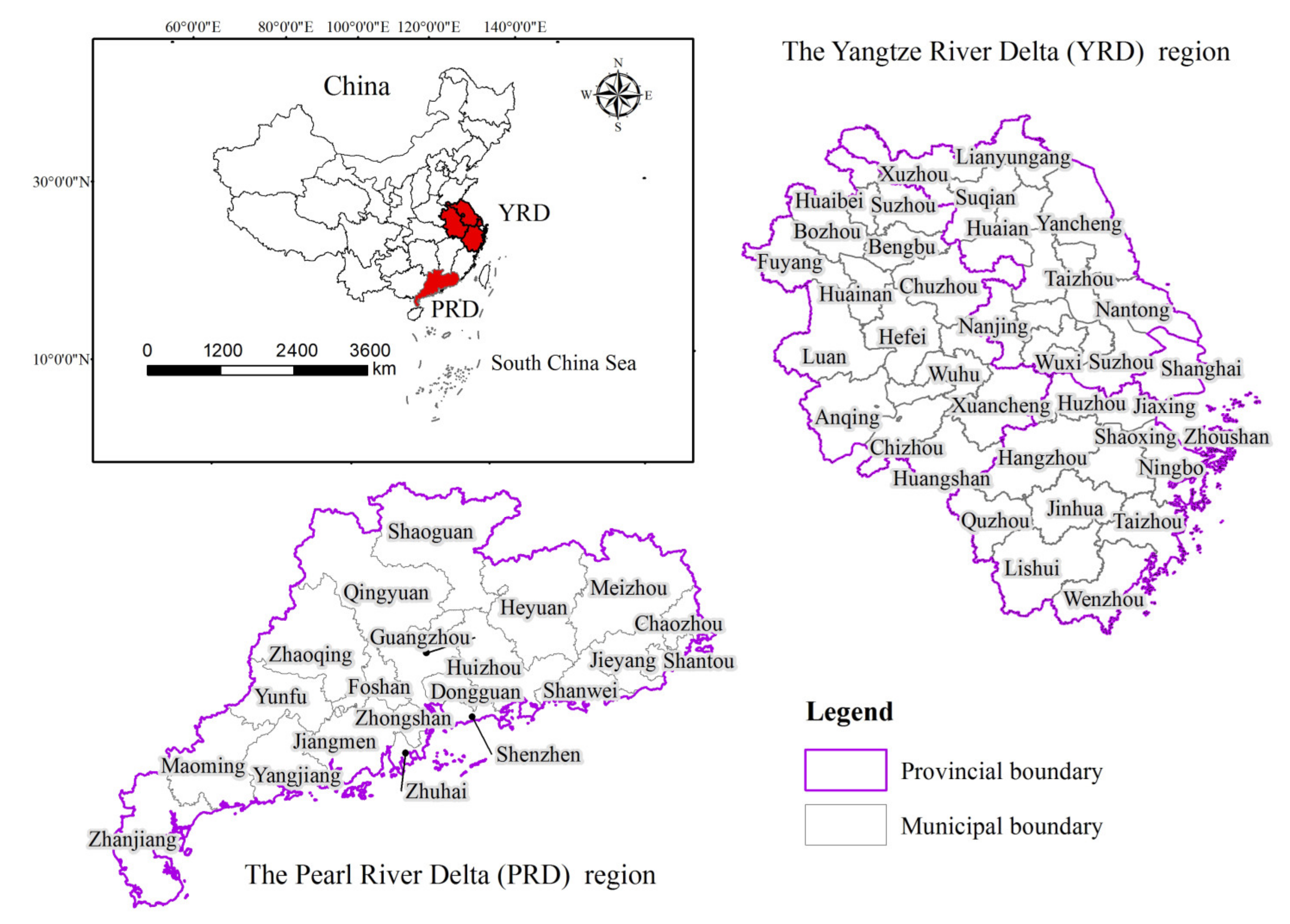

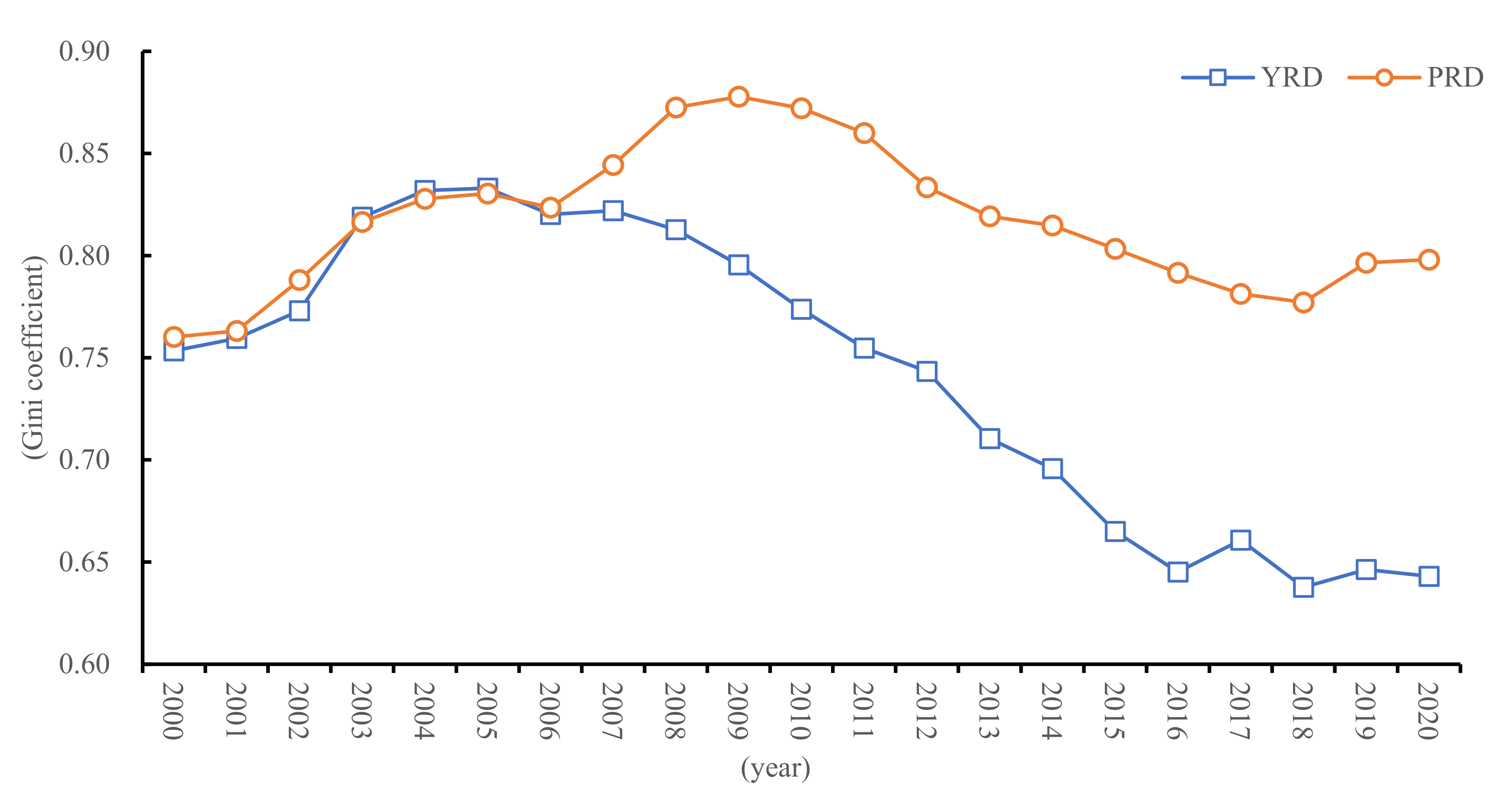
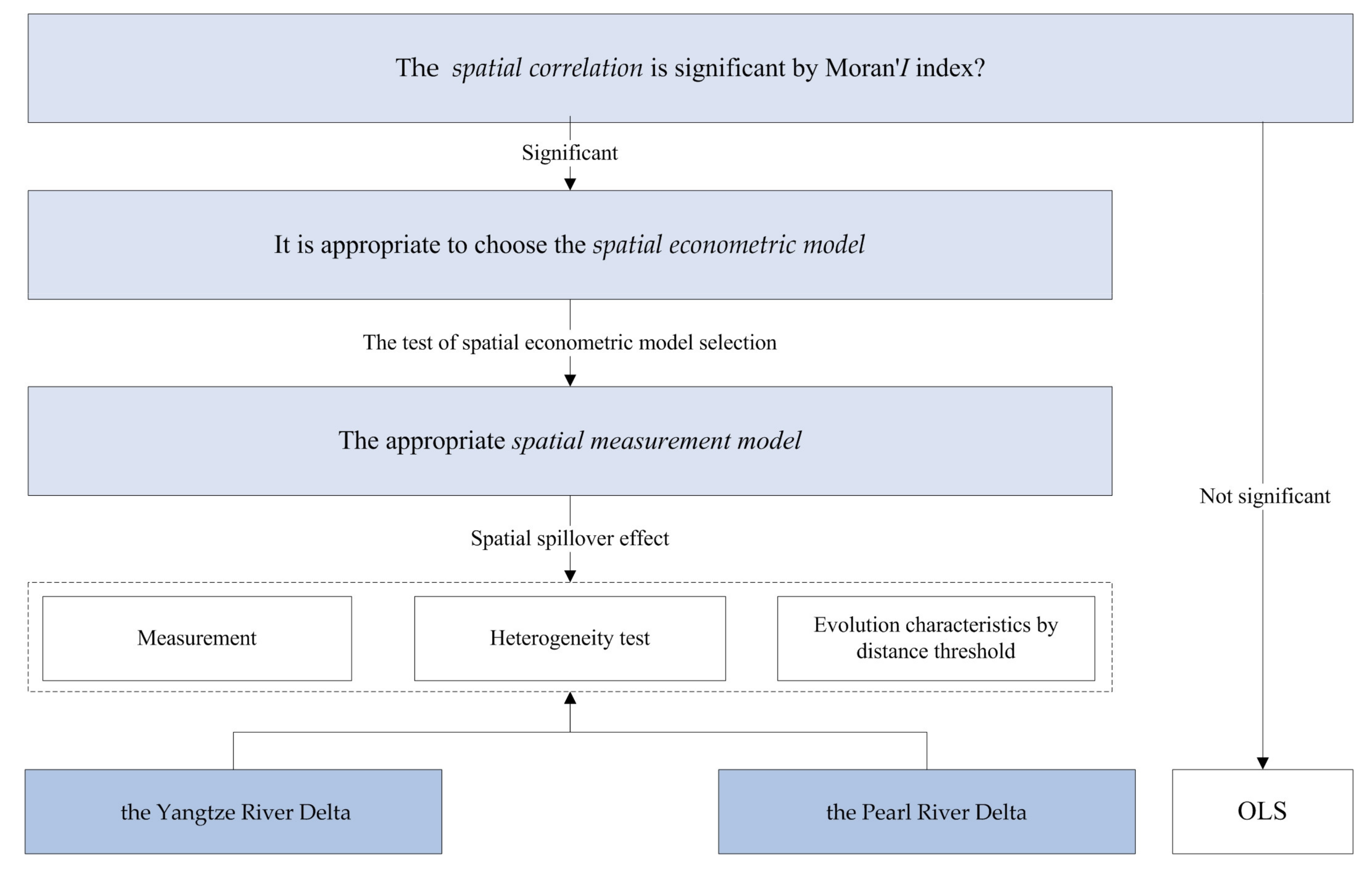
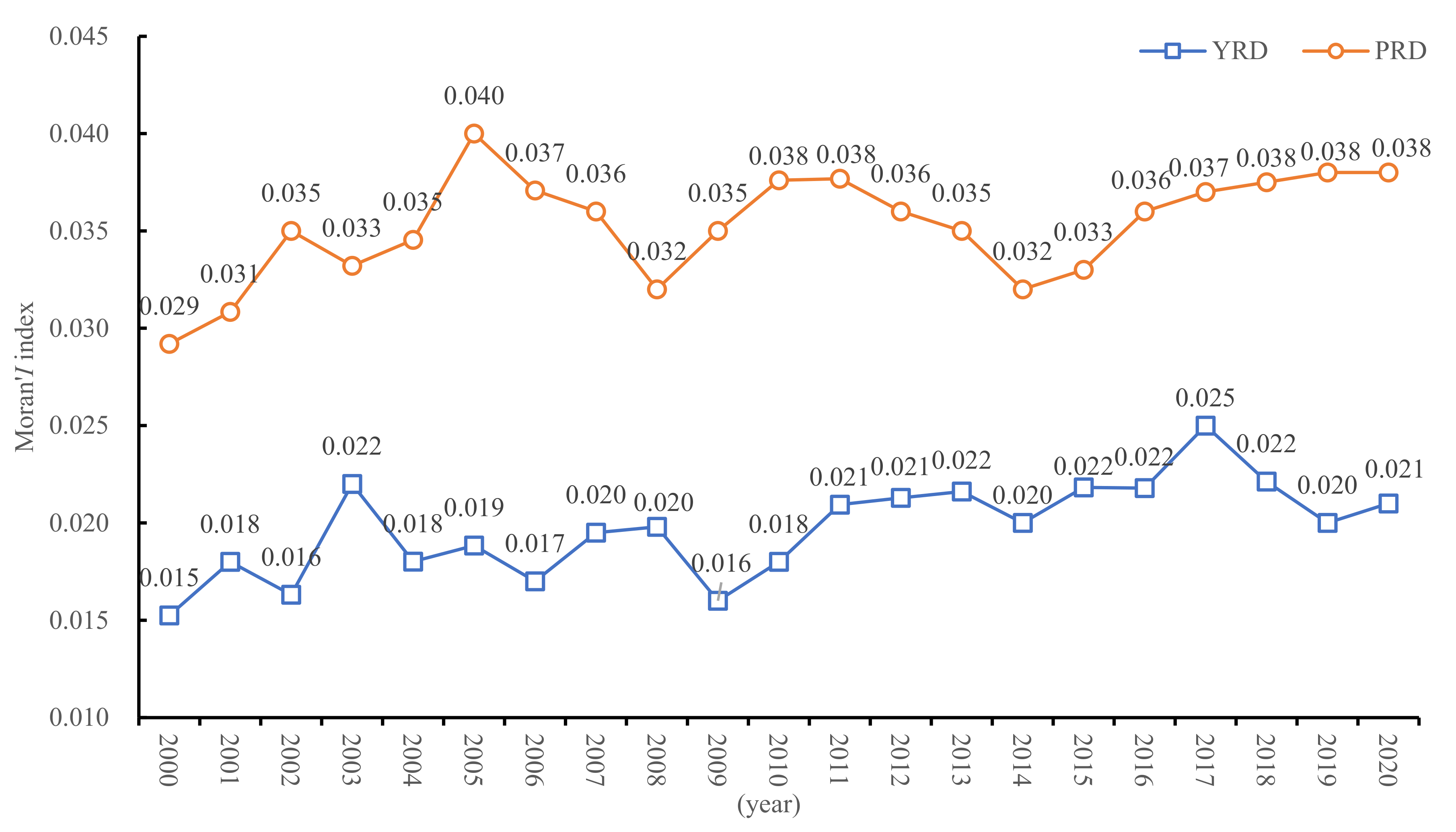
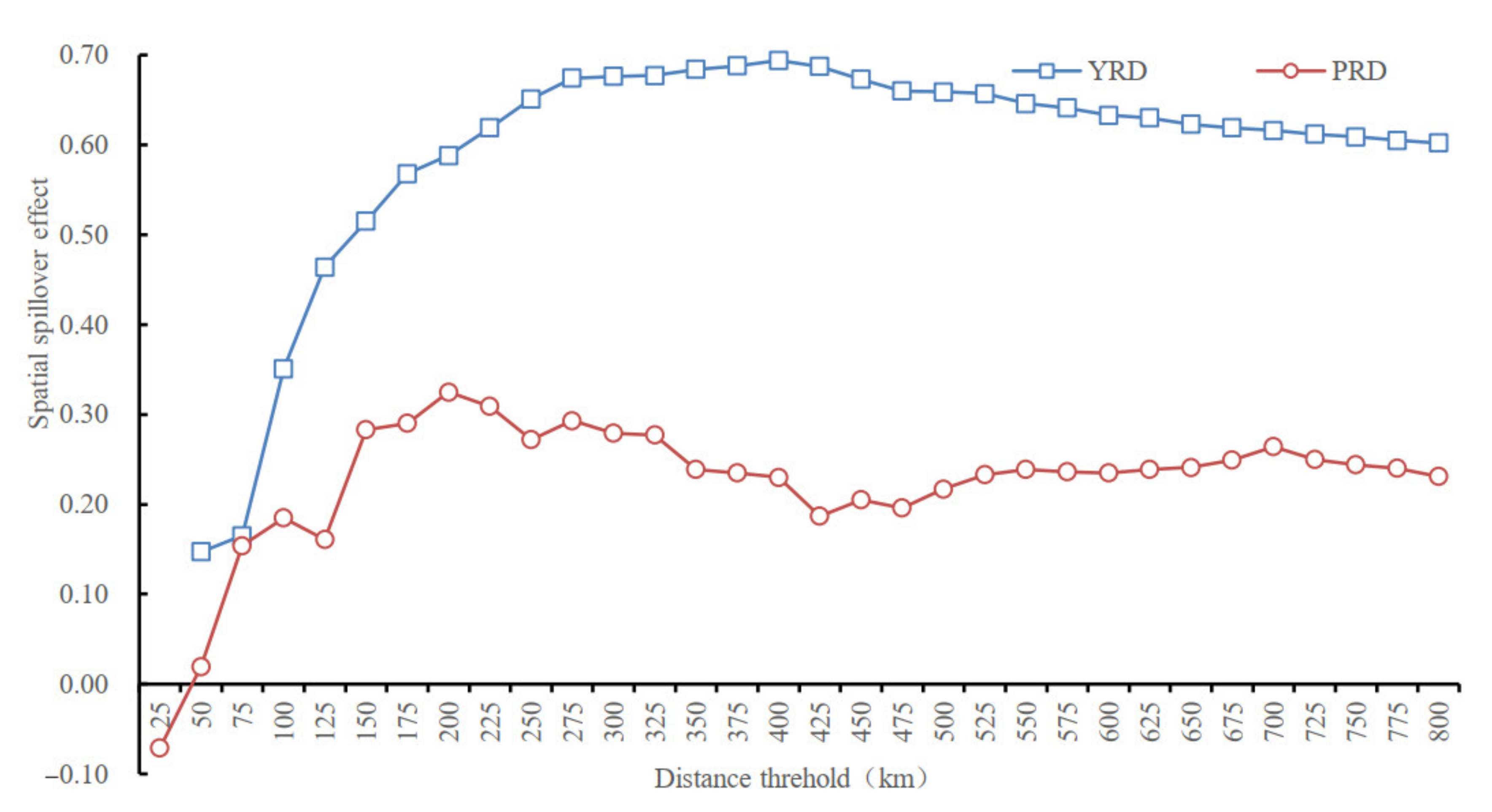
| Variable | H | K | Dep | Open | Fin | Tra | Constant | R2 |
|---|---|---|---|---|---|---|---|---|
| YRD | 0.242 *** (3.51) | 0.106 *** (3.71) | 0.0625 (0.38) | 0.0536 (0.92) | 1.507 *** (18.07) | 0.347 *** (5.06) | −13.193 *** (−11.79) | 0.920 |
| PRD | 1.005 *** (10.87) | 0.0695 (0.98) | 1.467 *** (6.21) | 0.0732 (0.68) | 0.145 (1.02) | 0.608 *** (5.48) | −25.962 ** (−12.68) | 0.872 |
| Test Indicator | YRD | PRD | ||
|---|---|---|---|---|
| Statistics | Probability | Statistics | Probability | |
| LM-lag | 22.98 | 0.0003 | 22.00 | 0.0005 |
| Robust LM-lag | 55.78 | 0.000 | 24.72 | 0.0004 |
| LM-error | 31.58 | 0.000 | 24.93 | 0.0004 |
| Robust LM-error | 40.49 | 0.000 | 52.06 | 0.000 |
| Wald-spatial lag | 24.33 | 0.0002 | 9.94 | 0.0770 |
| LR-spatial lag | 17.23 | 0.0085 | 63.76 | 0.0000 |
| Wald-spatial error | 32.38 | 0.0000 | 29.84 | 0.0000 |
| LR-spatial error | 82.14 | 0.0000 | 102.26 | 0.0000 |
| Hausman | 217.18 | 0.000 | 60.71 | 0.0000 |
| Variable | (1) | (2) |
|---|---|---|
| H | 0.0668 ** (2.14) | 0.472 *** (4.72) |
| K | 0.0920 *** (2.86) | −0.296 (−0.76) |
| Dep | −0.983 *** (−5.40) | 0.718 (1.08) |
| Open | 0.125 ** (2.40) | −0.315 (−0.84) |
| Fin | 0.526 *** (5.40) | 0.134 ** (1.97) |
| Tra | 0.140 ** (2.45) | 0.433 *** (4.41) |
| W × H | 0.361 (1.48) | −0.203 (−0.61) |
| W × K | −0.0942 * (−1.72) | 0.288 ** (1.91) |
| W × Dep | 0.310 *** (2.57) | 1.755 ** (2.06) |
| W × Open | 0.0272 (0.17) | 0.747 *** (3.19) |
| W × Fin | 0.0844 ** (2.03) | 0.164 (0.41) |
| W × Tra | 0.677 * (1.89) | 0.150 ** (2.55) |
| ρ | 0.604 *** (9.21) | 0.264 ** (2.27) |
| R2 | 0.942 | 0.901 |
| Variable | (1) | (2) | (3) | (4) |
|---|---|---|---|---|
| H | 0.0782 ** (2.29) | 0.424 *** (3.14) | 0.413 *** (4.12) | 0.435 *** (4.39) |
| K | 0.0978 *** (3.02) | 0.720 *** (2.86) | −0.170 (−1.05) | 0.198 * (1.91) |
| Dep | −0.868 *** (−4.90) | −0.195 ** (−2.34) | 0.386 (1.20) | 0.968 (0.89) |
| Open | 0.134 ** (2.48) | 0.725 ** (2.40) | −0.310 (−0.73) | 0.347 (1.15) |
| Fin | 0.611 *** (6.29) | 0.722 *** (9.31) | 0.190 (1.23) | 0.0629 *** (3.45) |
| Tra | 0.157 *** (2.62) | 0.340 ** (2.45) | 0.325 *** (3.22) | 0.452 *** (4.63) |
| W × H | 0.458 (1.53) | 0.561 ** (2.48) | −0.306 * (−1.81) | −0.0700 (−0.21) |
| W × K | −0.0492 ** (−2.11) | −0.0475 (−1.07) | 0.241 * (1.81) | 0.102 ** (1.99) |
| W × Dep | 0.582 ** (2.14) | 0.333 ** (2.02) | 0.477 ** (2.12) | 1.872 *** (2.62) |
| W × Open | 0.206 (0.23) | 0.0311 (0.39) | 0.656 *** (3.49) | 0.657 *** (2.82) |
| W × Fin | 0.508 *** (3.17) | 0.547 *** (2.60) | 0.670 (1.57) | 0.159 (0.41) |
| W × Tra | 0.320 *** (2.72) | 0.858 *** (2.86) | 0.285 *** (2.61) | 0.177 ** (2.15) |
| ρ | 0.297 *** (6.92) | 0.574 *** (8.59) | 0.272 *** (3.95) | 0.438 *** (3.00) |
| R2 | 0.937 | 0.949 | 0.900 | 0.902 |
| Variable | (1) | (2) | (3) | (4) |
|---|---|---|---|---|
| H | 0.0104 ** (2.12) | 0.0651 (0.82) | 0.420 *** (2.96) | 0.321 ** (2.23) |
| K | 0.116 ** (2.25) | 0.0643 (1.61) | 0.0520 (0.38) | −0.350 *** (−3.43) |
| Dep | 0.873 (1.06) | −0.537 ** (−2.11) | 0.632 (1.26) | −0.560 (−1.28) |
| Open | 0.349 *** (3.38) | 0.0619 (0.90) | −0.0780 (−0.24) | 0.0274 (0.25) |
| Fin | 0.404 **(2.19) | 0.361 *** (2.82) | 0.0301 ** (2.13) | −0.399 (−1.26) |
| Tra | −0.195 * (−1.91) | 0.276 *** (3.67) | 0.113 (0.59) | 0.292 *** (2.77) |
| W × H | 0.437 * (1.94) | 0.739 (1.49) | −0.685 ** (−2.03) | −0.367 (−0.79) |
| W × K | −0.0380 (−0.55) | −0.0744 (−0.95) | −0.174 (−0.47) | 0.269 ** (2.13) |
| W × Dep | 1.251 ** (2.36) | 0.207 (0.26) | 2.151 (1.49) | 2.311 *** (3.74) |
| W × Open | −0.274 * (−1.69) | −0.0584 (−0.19) | 0.523 (0.85) | 0.306 (1.48) |
| W × Fin | −0.263 (−1.06) | 0.243 (0.49) | 0.0970 (0.13) | 0.430 (1.54) |
| W × Tra | 0.660 * (1.75) | 0.489 (1.21) | 0.0718 (0.13) | −0.227 (−0.88) |
| ρ | 0.646 *** (7.63) | 0.170 *** (5.48) | 0.279 ** (2.40) | 0.0995 (0.75) |
| R2 | 0.960 | 0.935 | 0.944 | 0.891 |
| Variable | (1) | (2) | (3) | (4) |
|---|---|---|---|---|
| H | −0.425 (−1.24) | 0.619 *** (2.99) | 0.0281 (0.13) | 0.276 ** (2.58) |
| K | −0.0207 (−0.48) | 0.440 *** (6.22) | −0.269 *** (−3.22) | 0.356 * (1.76) |
| Dep | −0.993 *** (−3.13) | −0.483 (−1.61) | −2.107 *** (−2.92) | 0.0898 (0.27) |
| Open | 0.212 (1.64) | 0.356 *** (4.68) | −0.137 (−0.87) | 0.00659 (0.04) |
| Fin | 0.707 *** (3.97) | 0.0129 (0.11) | 0.0505 (0.19) | 0.527 ** (2.31) |
| Tra | −0.0430 (−0.25) | 0.269 *** (2.93) | 0.310 * (1.95) | −0.183 (−1.29) |
| W × H | −2.139 (−0.81) | 0.712 (0.31) | −3.520 * (−1.80) | −0.0784 (−0.05) |
| W × K | −0.283 *** (−2.99) | 1.103 (1.53) | 0.333 ** (1.97) | 1.481 ** (2.42) |
| W × Dep | −0.976 ** (−2.57) | 3.553 *** (2.82) | 0.927 (0.66) | −1.468 * (−1.65) |
| W × Open | 5.274 *** (2.83) | −1.002 *** (−3.36) | 3.461 *** (2.67) | −0.253 (−0.61) |
| W × Fin | 0.376 (0.20) | 0.322 (1.27) | −1.515 (−0.99) | 0.327 (0.71) |
| W × Tra | 0.66 (1.42) | 0.871 ** (2.10) | 0.414 *** (2.65) | 0.0867 (0.00) |
| ρ | −0.861 ** (−2.13) | 0.688 *** (3.40) | 0.245 (1.48) | 0.286 *** (2.86) |
| R2 | 0.734 | 0.898 | 0.733 | 0.821 |
Disclaimer/Publisher’s Note: The statements, opinions and data contained in all publications are solely those of the individual author(s) and contributor(s) and not of MDPI and/or the editor(s). MDPI and/or the editor(s) disclaim responsibility for any injury to people or property resulting from any ideas, methods, instructions or products referred to in the content. |
© 2023 by the author. Licensee MDPI, Basel, Switzerland. This article is an open access article distributed under the terms and conditions of the Creative Commons Attribution (CC BY) license (https://creativecommons.org/licenses/by/4.0/).
Share and Cite
Yan, D. Measurement and Comparison of the Innovation Spatial Spillover Effect: A Study Based on the Yangtze River Delta and the Pearl River Delta, China. Systems 2023, 11, 90. https://doi.org/10.3390/systems11020090
Yan D. Measurement and Comparison of the Innovation Spatial Spillover Effect: A Study Based on the Yangtze River Delta and the Pearl River Delta, China. Systems. 2023; 11(2):90. https://doi.org/10.3390/systems11020090
Chicago/Turabian StyleYan, Dongsheng. 2023. "Measurement and Comparison of the Innovation Spatial Spillover Effect: A Study Based on the Yangtze River Delta and the Pearl River Delta, China" Systems 11, no. 2: 90. https://doi.org/10.3390/systems11020090




